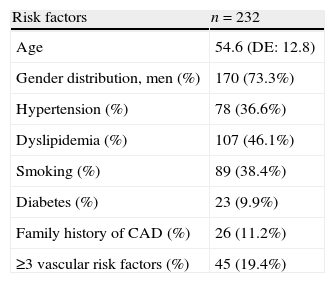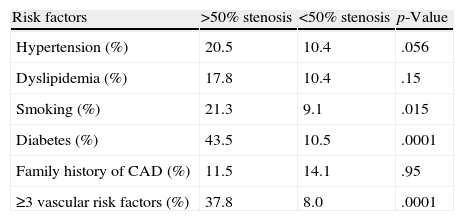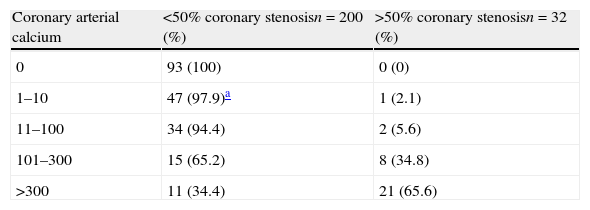To confirm the value of the coronary artery calcium (CAC) score as an indicator of significant coronary artery disease (CAD) in the asymptomatic Spanish population, using noninvasive coronary angiography by multidetector computed tomography (MDCT).
MethodsThis was a retrospective study of 232 asymptomatic individuals, referred for a cardiovascular health checkup that included CAC and MDCT.
ResultsParticipants’ mean age was 54.6 years (SD±12.8); 73.3% of them were men. The mean CAC value was 117.8 (SD±277). The individuals with arterial hypertension, diabetes mellitus, smoking and 3 or more risk factors had significantly greater CAC scores. Some 16.4% of the participants were in the ≥75th percentile population for CAC. The MDCT identified 148 individuals (63.8%) with CAD; the coronary lesions were not significant in 116 individuals (50%) and were significant (>50% stenosis) in 32 (13.8%). The participants with diabetes, smoking and ≥3 risk vascular factors had a greater prevalence of significant stenosis. The individuals with >50% stenosis had higher CAC values (352.5 vs. 1; p<.0001), and those in the ≥75th percentile had a high percentage of significant lesions (57.9% vs. 5.2%; p<.0001). The predictors of significant CAD were a CAC score >300 (OR=10.9; 95% CI 3.35–35.8; p=.0001), belonging to the ≥75th percentile (OR=5.65; 95% CI 1.78–17.93; p=.03) and having 3 or more vascular risk factors (OR=4.19; 95% CI 1.44–12.14; p=.008).
ConclusionCAC quantification is an effective method for determining the extent and magnitude of CAD and delimiting the predictive capacity of traditional risk factors.
Confirmar el valor de la puntuación o score del calcio arterial coronario (CAC) como indicador de enfermedad arterial coronaria (EAC) significativa en población española asintomática, mediante coronariografía no invasiva por tomografía computarizada multidetector (TCMD).
MétodosEstudio retrospectivo de 232 individuos asintomáticos, remitidos para un chequeo de salud cardiovascular que incluyó CAC y TCMD.
ResultadosLa edad media de los sujetos estudiados fue de 54,6 años (DE: 12,8; 73,3% varones). El valor medio del CAC fue de 117,8 (DE: 277). Los individuos con hipertensión arterial, diabetes mellitus, tabaquismo y con ≥3 factores de riesgo mostraron un CAC significativamente mayor. Un 16,4% de los sujetos se encontraban en el percentil poblacional ≥75 de CAC. La TCMD identificó a 148 individuos (63,8%) con EAC, siendo las lesiones coronarias no significativas en 116 individuos (50%) y significativas (estenosis>50%) en 32 (13,8%). Los sujetos con diabetes, tabaquismo y ≥3 factores de riesgo vascular mostraron una mayor prevalencia de estenosis significativa. Los individuos con estenosis>50% presentaron valores de CAC superiores (352,5 vs. 1; p<0,0001) y los de percentil ≥75 presentaron un alto porcentaje de lesiones (57,9 vs. 5,2%; p<0,0001). Como variables predictoras de EAC significativa destacaron el CAC >300 (OR=10,9; IC95%: 3,35-35,8; p=0,0001), ocupar un percentil ≥75 (OR=5,65; IC95%: 1,78-17,93; p=0,03) y la agrupación de ≥3 factores de riesgo vascular (OR=4,19; IC95%: 1,44-12,14; p=0,008).
ConclusiónLa cuantificación del CAC es un método eficaz para determinar la extensión y magnitud de la EAC y delimitar la capacidad predictiva de los factores de riesgo tradicionales.
Article
Diríjase desde aquí a la web de la >>>FESEMI<<< e inicie sesión mediante el formulario que se encuentra en la barra superior, pulsando sobre el candado.

Una vez autentificado, en la misma web de FESEMI, en el menú superior, elija la opción deseada.

>>>FESEMI<<<










